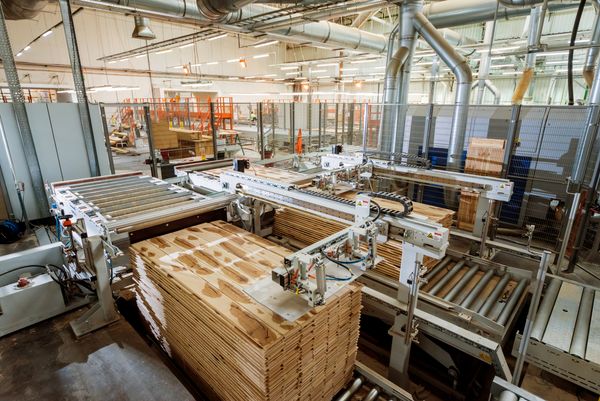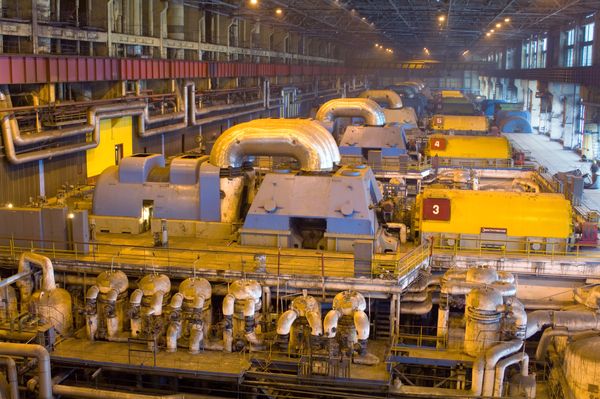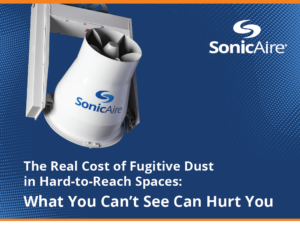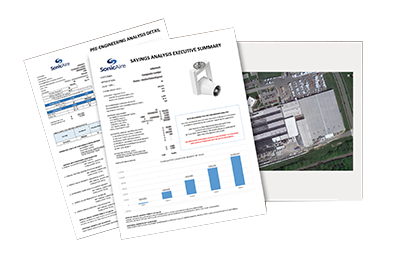Insurance companies will ask you plenty of questions when assessing what kind of coverage they can offer your company. They dig so deep into your facility and operations that you may be wondering how important each question really is to your policy.
The dust build-up in your rafters may be overlooked when it comes to your facility’s maintenance checklist. So, how much can an insurance company care about a bit of dust?
The answer is A LOT!
 Dust build-up may seem like the cost of doing business in a manufacturing world. But, even in the rafters, your commitment to cleanliness is a high priority for your insurer and is absolutely something they’re keeping an eye out for.
Dust build-up may seem like the cost of doing business in a manufacturing world. But, even in the rafters, your commitment to cleanliness is a high priority for your insurer and is absolutely something they’re keeping an eye out for.
Recently, Jordan Newton, COO of SonicAire, sat down with Dan Braiman from Pennsylvania Lumbermens Mutual Insurance to get the truth behind insurance coverage for manufacturing companies – straight from the source. Pennsylvania Lumbermens Mutual Insurance Company (PLM) is the oldest insurance company dedicated to serving wood products and building material industries. Dan, currently a Loss Control Manager with PLM, has worked in insurance for the lumber industry for 17 years.
A Better Understanding of Dust
Dust build-up control has always been a priority for insurance companies in order to avoid catastrophic loss. Maintaining a clean facility where dust doesn’t reach dangerous accumulation levels indicates you prioritize your facility and your employees’ safety. Well-kept facilities have fewer preventable risks, creating an environment insurance companies love to see when evaluating a business for coverage.
Monitoring dust buildup is more than just an indicator of a facility’s cleanliness and maintenance. Insurance companies have always looked for dust in a facility, considering it a huge safety risk. The thought used to be that dust on the walls and in the rafters was a “fuse” risk. It would spread fire throughout a facility wherever the dust had accumulated, acting as a fuel. This still holds true, in a sense.
But now we know it isn’t that simple.
The Real Cost of Manual Dust Cleaning
It isn’t until you sit down and start adding up all of the costs the problem becomes apparent.
Braiman explains, “What later was revealed about that was […] it’s actually the case that it creates an explosion hazard.” When the science behind combustible dust became more widely known and insurance companies realized that it wouldn’t merely spread explosions but would explode itself, dust became all the more important to assess. With this realization, all facilities began to make dust mitigation a priority, particularly those working in lumber facilities, like the kind PLM insures.
When a facility allows dust to pile up, even in unseen rafters, the risk for destruction skyrockets. All it takes is one ignition source to meet this combustion source, and the results could be catastrophic.
What Do Insurance Companies Look For?
If you’re interested in hearing more about what insurers look for, check out what Dan Braiman says below.
The biggest element an insurance company looks for during a pre-inspection is maintenance. They want to see you’ve demonstrated an employer’s duty of care, and they can find this by looking closely at your:
- Dust Hazard Analysis (DHA) – OSHA does require a DHA, but more than that, when an insurance company sees you have one, it goes a long way towards getting the best premiums possible.
- Housekeeping Maintenance – Along with the DHA, insurers ask several housekeeping questions. Is the plant clean and dust free? Do you have records on what cleaning is done and when?
- Electrical Maintenance – Have you performed audits on your electrical components? Do you keep your records organized and easily accessed? Electrical issues in your facility can easily produce an ignition source that causes dust combustion. Your insurer will want to see that you’re considering this and taking measures to prevent it.
- Equipment Maintenance – Do you maintain your machinery regularly to ensure it functions optimally and safely? Do you document your maintenance? Just as with electrical concerns, a machine that isn’t well-maintained is more likely to malfunction. Any malfunctioning equipment that causes just one spark is a combustion risk when you have dust build-up.

That’s where a Dust Hazard Analysis will really work in your favor.
Without the DHA, you’ll find insurers sleuthing around your facility. They have plenty of tactics to catch potential tricks and workarounds for housekeeping. One of the most obvious tells of dust management is coloration. Insurers can tell just how often you vacuum your combustible dust based on the dust’s colors and layers. Wood dust dries quickly, and as it dries, it deepens in color. If you have layers of dust in different shades, your insurer knows exactly how diligent you are at your housekeeping. Even if you don’t have wood dust in your facility, different powders from different products will create layers and colors that reveal your housekeeping practices.
Several dust-related disasters have fueled systems in insurance requirements regarding combustible dust. For example, dust collection devices that gather wood dust could create an environment with a higher risk of an internal explosion. Insurance companies now require several safeguards to prevent this.
A flame and spark suppression system will detect ignition sources within the collector and douse them with water. Additionally, dust collectors must have an “abort” gate that slams shut and ventilates any fire via an exterior vent.
Braiman cites one instance where a source of ignition reached the dust collection tanks. The explosion released from the tanks occurred directly above employees’ heads and was described as “a giant fireball.” Thankfully, the tanks were located high up in the ceiling, and the facility had excellent housekeeping practices, so the damage wasn’t as disastrous as it could have been. Very quickly, the changes PLM had recommended for years became a priority for the organization.
How SonicAire Can Help
For maintenance of combustible dust, a rigorous dust management system is essential to your facility’s safety – and for getting the best price on your insurance policy.
SonicAire is often asked whether their fans are “OSHA-approved,” and the answer is a resounding yes. But there’s more to it than a simple affirmative. OSHA can’t endorse one company or one brand, but they do cite where they collect data regarding their fire regulations and guidelines.
SonicAire fans are approved in the National Fire Protection Association (NFPA) standard 652, and the NFPA is, as Braiman says, the “go-to reference for all OSHA-related guidelines.”

Beyond the added protection provided by minimizing combustible dust in overhead spaces, you’ll also appreciate the potential insurance benefits. Each insurance company’s discounts and benefits are different, but having a SonicAire system may save you a little extra, too. PLM has partnered with SonicAire to offer their clients a one-time discount of $500 on their purchase. They may also extend an offer of a better premium after seeing the care you display for your employees and your facility by mitigating combustible dust accumulation.
SonicAire fans eliminate the need to maintain meticulous documentation, reducing stress on your maintenance team and speeding up your insurance inspection.
Of course, you’ll still need to keep up on your documentation, but SonicAire fans show an insurer that you’re already doing the best thing possible to prevent combustible dust build-up in your overhead spaces. You’ll no longer need to regularly maintain and produce records of recurring cleaning. Quick visual inspections conducted by insurance companies will save you production downtime and worry about increased policy costs.
When an insurer can quickly spot your mitigation efforts, the judgment on dust is pretty simple:
No dust, no danger.
If your facility could use a better way to control dust, click here to request a Complimentary Dust Management Plan and ROI Analysis. Getting ahead of the problem may qualify your company for more insurance options and better coverage.
SonicAire Fans – A Cost-Effective Alternative
We’re not going to lie to you. Installing a SonicAire Dust Control Fan System requires an investment. There are very few facilities that can get by with a couple of fans. But the long-term benefits speak for themselves.
SonicAire fans either run for specified periods during the day or all day, depending upon your operations and dust production level. However, they use two different tactics to prevent combustible dust buildup in overhead areas.
First, they clean off higher surfaces with continual airflow. This prevents buildup and eliminates the cleaning of these areas. Second, a properly engineered system creates an Air Barrier to prevent warm air currents from bringing dust up into overhead spaces.
Let’s look at how they impact the costs we’ve highlighted above.
Measuring the Difference
Each facility is different. In manufacturing and processing, operations produce varying levels and types of fugitive dust. But each facility is likely overspending on manual cleaning or simply not cleaning enough.
When you consider the labor, equipment, and lost productivity that goes into manual cleaning practices and then add in the insurance costs, potential fines, and employee dissatisfaction. Is manually cleaning your facility really saving you money?
We’re confident our combustible dust control systems will save your facility money even with the initial investment to purchase and install. But, if you’re not 100% sold, we get it. That’s why we offer free dust management plans with ROI Analysis. These engineered plans recommend the amount and placing of fans to ensure maximum protection from dust buildup.
Click here to request your Free Dust Management Plan.
Or contact us to discuss dust control solutions for your facility.
Insurance companies will ask you plenty of questions when assessing what kind of coverage they can offer your company. They dig so deep into your facility and operations that you may be wondering how important each question really is to your policy.
The dust build-up in your rafters may be overlooked when it comes to your facility’s maintenance checklist. So, how much can an insurance company care about a bit of dust?
The answer is A LOT!
 Dust build-up may seem like the cost of doing business in a manufacturing world. But, even in the rafters, your commitment to cleanliness is a high priority for your insurer and is absolutely something they’re keeping an eye out for.
Dust build-up may seem like the cost of doing business in a manufacturing world. But, even in the rafters, your commitment to cleanliness is a high priority for your insurer and is absolutely something they’re keeping an eye out for.
Recently, Jordan Newton, COO of SonicAire, sat down with Dan Braiman from Pennsylvania Lumbermens Mutual Insurance to get the truth behind insurance coverage for manufacturing companies – straight from the source. Pennsylvania Lumbermens Mutual Insurance Company (PLM) is the oldest insurance company dedicated to serving wood products and building material industries. Dan, currently a Loss Control Manager with PLM, has worked in insurance for the lumber industry for 17 years.
A Better Understanding of Dust
Dust build-up control has always been a priority for insurance companies in order to avoid catastrophic loss. Maintaining a clean facility where dust doesn’t reach dangerous accumulation levels indicates you prioritize your facility and your employees’ safety. Well-kept facilities have fewer preventable risks, creating an environment insurance companies love to see when evaluating a business for coverage.
Monitoring dust buildup is more than just an indicator of a facility’s cleanliness and maintenance. Insurance companies have always looked for dust in a facility, considering it a huge safety risk. The thought used to be that dust on the walls and in the rafters was a “fuse” risk. It would spread fire throughout a facility wherever the dust had accumulated, acting as a fuel. This still holds true, in a sense.
But now we know it isn’t that simple.
Braiman explains, “What later was revealed about that was […] it’s actually the case that it creates an explosion hazard.” When the science behind combustible dust became more widely known and insurance companies realized that it wouldn’t merely spread explosions but would explode itself, dust became all the more important to assess. With this realization, all facilities began to make dust mitigation a priority, particularly those working in lumber facilities, like the kind PLM insures.
When a facility allows dust to pile up, even in unseen rafters, the risk for destruction skyrockets. All it takes is one ignition source to meet this combustion source, and the results could be catastrophic.
What Do Insurance Companies Look For?
If you’re interested in hearing more about what insurers look for, check out what Dan Braiman says below.
The biggest element an insurance company looks for during a pre-inspection is maintenance. They want to see you’ve demonstrated an employer’s duty of care, and they can find this by looking closely at your:
- Dust Hazard Analysis (DHA) – OSHA does require a DHA, but more than that, when an insurance company sees you have one, it goes a long way towards getting the best premiums possible.
- Housekeeping Maintenance – Along with the DHA, insurers ask several housekeeping questions. Is the plant clean and dust free? Do you have records on what cleaning is done and when?
- Electrical Maintenance – Have you performed audits on your electrical components? Do you keep your records organized and easily accessed? Electrical issues in your facility can easily produce an ignition source that causes dust combustion. Your insurer will want to see that you’re considering this and taking measures to prevent it.
- Equipment Maintenance – Do you maintain your machinery regularly to ensure it functions optimally and safely? Do you document your maintenance? Just as with electrical concerns, a machine that isn’t well-maintained is more likely to malfunction. Any malfunctioning equipment that causes just one spark is a combustion risk when you have dust build-up.

That’s where a Dust Hazard Analysis will really work in your favor.
Without the DHA, you’ll find insurers sleuthing around your facility. They have plenty of tactics to catch potential tricks and workarounds for housekeeping. One of the most obvious tells of dust management is coloration. Insurers can tell just how often you vacuum your combustible dust based on the dust’s colors and layers. Wood dust dries quickly, and as it dries, it deepens in color. If you have layers of dust in different shades, your insurer knows exactly how diligent you are at your housekeeping. Even if you don’t have wood dust in your facility, different powders from different products will create layers and colors that reveal your housekeeping practices.
Several dust-related disasters have fueled systems in insurance requirements regarding combustible dust. For example, dust collection devices that gather wood dust could create an environment with a higher risk of an internal explosion. Insurance companies now require several safeguards to prevent this.
A flame and spark suppression system will detect ignition sources within the collector and douse them with water. Additionally, dust collectors must have an “abort” gate that slams shut and ventilates any fire via an exterior vent.
Braiman cites one instance where a source of ignition reached the dust collection tanks. The explosion released from the tanks occurred directly above employees’ heads and was described as “a giant fireball.” Thankfully, the tanks were located high up in the ceiling, and the facility had excellent housekeeping practices, so the damage wasn’t as disastrous as it could have been. Very quickly, the changes PLM had recommended for years became a priority for the organization.
How SonicAire Can Help
For maintenance of combustible dust, a rigorous dust management system is essential to your facility’s safety – and for getting the best price on your insurance policy.
SonicAire is often asked whether their fans are “OSHA-approved,” and the answer is a resounding yes. But there’s more to it than a simple affirmative. OSHA can’t endorse one company or one brand, but they do cite where they collect data regarding their fire regulations and guidelines.
SonicAire fans are approved in the National Fire Protection Association (NFPA) standard 652, and the NFPA is, as Braiman says, the “go-to reference for all OSHA-related guidelines.”

Beyond the added protection provided by minimizing combustible dust in overhead spaces, you’ll also appreciate the potential insurance benefits. Each insurance company’s discounts and benefits are different, but having a SonicAire system may save you a little extra, too. PLM has partnered with SonicAire to offer their clients a one-time discount of $500 on their purchase. They may also extend an offer of a better premium after seeing the care you display for your employees and your facility by mitigating combustible dust accumulation.
SonicAire fans eliminate the need to maintain meticulous documentation, reducing stress on your maintenance team and speeding up your insurance inspection.
Of course, you’ll still need to keep up on your documentation, but SonicAire fans show an insurer that you’re already doing the best thing possible to prevent combustible dust build-up in your overhead spaces. You’ll no longer need to regularly maintain and produce records of recurring cleaning. Quick visual inspections conducted by insurance companies will save you production downtime and worry about increased policy costs.
When an insurer can quickly spot your mitigation efforts, the judgment on dust is pretty simple:
No dust, no danger.
If your facility could use a better way to control dust, click here to request a Complimentary Dust Management Plan and ROI Analysis. Getting ahead of the problem may qualify your company for more insurance options and better coverage.
The Real Cost of Manual Dust Cleaning
It isn’t until you sit down and start adding up all of the costs the problem becomes apparent.
SonicAire Fans – A Cost-Effective Alternative
We’re not going to lie to you. Installing a SonicAire Dust Control Fan System requires an investment. There are very few facilities that can get by with a couple of fans. But the long-term benefits speak for themselves.
SonicAire fans either run for specified periods during the day or all day, depending upon your operations and dust production level. However, they use two different tactics to prevent combustible dust buildup in overhead areas.
First, they clean off higher surfaces with continual airflow. This prevents buildup and eliminates the cleaning of these areas. Second, a properly engineered system creates an Air Barrier to prevent warm air currents from bringing dust up into overhead spaces.
Let’s look at how they impact the costs we’ve highlighted above.
Measuring the Difference
Each facility is different. In manufacturing and processing, operations produce varying levels and types of fugitive dust. But each facility is likely overspending on manual cleaning or simply not cleaning enough.
When you consider the labor, equipment, and lost productivity that goes into manual cleaning practices and then add in the insurance costs, potential fines, and employee dissatisfaction. Is manually cleaning your facility really saving you money?
We’re confident our combustible dust control systems will save your facility money even with the initial investment to purchase and install. But, if you’re not 100% sold, we get it. That’s why we offer free dust management plans with ROI Analysis. These engineered plans recommend the amount and placing of fans to ensure maximum protection from dust buildup.
Click here to request your Free Dust Management Plan.
Or contact us to discuss dust control solutions for your facility.

GET YOUR FREE GUIDE:
The Real Cost of Fugitive Dust in Hard-to-Reach Spaces
What You Can’t See Can Hurt You
To help protect your workplace, we’ve compiled the following resource, The Real Cost of Fugitive Dust in Hard-to-Reach Spaces: What You Can’t See Can Hurt You. In it, we identify seven ways fugitive dust is likely impacting your facility and its profitability.
These costs go beyond housekeeping and explain why you should be preventing dust buildup to protect the bottom line, not just to stay in compliance.

